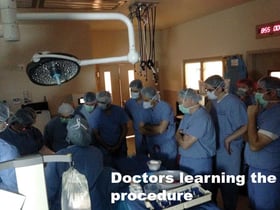Varicose veins can be more than just an annoyance. Aside from the cosmetic dissatisfaction, they can cause aching pain, edema, discomfort and when left untreated, ulceration. Treatments such as schlerotherapy and laser may require several treatment sessions and often are followed by recurrence and discoloration.
Ambulatory phlebectomy reduces the risk of recurrence and discoloration; however, the veins are blindly removed through numerous incisions during an often lengthy and tedious procedure. Patients may be left with numerous scars from the incisions and segments may also be left behind which may require additional treatments. Transilluminated Powered Phlebectomy (TIPP), using the TRIVEX System (LeMaitre Vascular Inc., Burlington, MA) offers an alternate solution by using light to provide transillumination, allowing for targeted vein removal through minimal, tiny incisions. Since development in 1996, thousands of patients have benefited from TIPP, a safe and effective procedure for the treatment of varicose veins. In one study, 99.7% (338/339) of patients reported good outcomes and were satisfied by the procedure.[1] There are multiple studies confirming that fewer incisions contribute to reduced post-operative pain and better cosmesis.[1], [2], [3]
Learning with the TRIVEX System
 As with any procedure, there is a learning curve for surgeons utilizing the TRIVEX System. Surgical device training is important to achieve successful outcomes more quickly. LeMaitre Vascular offers training programs hosted by surgeons with significant TRIVEX experience to assist surgeons through the learning curve and get them up and running quickly. Trainings are available in both a live, on-site format as well as a web based format to suit the needs and availability of the surgeon. The live format includes a slide presentation and live case observation(s), and is currently being offered in Chicago, Illinois; Englewood, New Jersey; and Ann Arbor, Michigan. The webinar trainings include an interactive slide presentation and discussion. Both training formats offer ample opportunity to ask questions and seek advice from the training surgeon, leveraging on the trainer’s vast experience with the system.
As with any procedure, there is a learning curve for surgeons utilizing the TRIVEX System. Surgical device training is important to achieve successful outcomes more quickly. LeMaitre Vascular offers training programs hosted by surgeons with significant TRIVEX experience to assist surgeons through the learning curve and get them up and running quickly. Trainings are available in both a live, on-site format as well as a web based format to suit the needs and availability of the surgeon. The live format includes a slide presentation and live case observation(s), and is currently being offered in Chicago, Illinois; Englewood, New Jersey; and Ann Arbor, Michigan. The webinar trainings include an interactive slide presentation and discussion. Both training formats offer ample opportunity to ask questions and seek advice from the training surgeon, leveraging on the trainer’s vast experience with the system.
LeMaitre Vascular follows the training with an opportunity for an evaluation system to be placed in the hospital or surgery center. This allows the newly trained surgeons to immediately put their new knowledge to use and allows a hospital or surgery center to test the feasibility of acquiring the system. Alternately, if a surgeon is unable to leave his or her practice, a surgeon trainer can spend a day proctoring TIPP cases on-site. In this situation, the evaluation system can be placed earlier, prior to the training date, to allow staff to be in-serviced on the system and for it to be used during the training day.
TRIVEX Consultation
Once the TRIVEX System has been purchased or leased by a hospital or surgery center, LeMaitre Vascular offers continued support in helping to promote the practice and the procedure. Sales representatives offer staff in-servicing to help make sure that cases go smoothly and are available to provide support in the operating room. Patient flyers, posters, and website materials are available. LeMaitre Vascular can also provide referral mailing templates for use in mailings to area physicians. The sales representative can also assist in coordinating referral events introducing the technology to area physicians, such as lunch and learn events or dinner programs.
The TRIVEX System offers many benefits to the surgeon and patients resulting in higher patient satisfaction, shorter recovery time and improved cosmesis. By utilizing the different training options and evaluation systems, surgeons can learn from experienced surgeons and shorten the learning curve to provide patients with a minimally invasive solution for varicose veins.
1. Franz RW, Knapp ED. Annals of Vasc Surg. 2008; 23(3):303-309.
2. Passman M. Vascular. 2007; 15:262-268.
3. Aremu MA, Mahendran B, Butcher W, Khan Z, Colgan MP, Moore DJ, et al. J Vasc Surg. 2004; 39:88-94.


